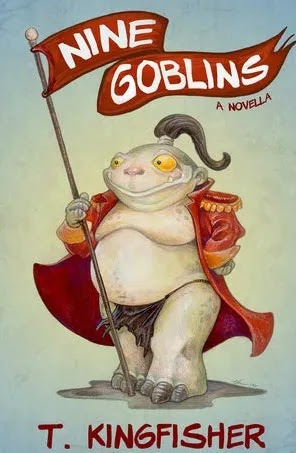Genre: Fantasy
Publication Date: 1983
Number of Pages: 277
Geographical Setting: The Discworld
Plot Summary: The Discworld is experiencing a new phenomenon some strange practice known as, "tourism." When Twoflower arrives Ankh-Morpork, the biggest city on the Discworld, with his sentient luggage in hand and a bag of gold in the other everyone wants a piece of him. Rincewind, a failed wizard who was kicked out of school after accidentally getting an ancient spell stuck in his head, is forced to be his tour guide while he is visiting the hublands. They visit the city of Quirm (while being used as pieces in a board game played by the gods), they travel through Wyrmberg where riders ride imaginary dragons, and many other misadventures.
Subject Headings:
- Adventures - Fiction
- Dragons - Fiction
- Humor - Fiction
Fantasy Appeals:
Setting: "Worldbuilding is the central appeal of Fantasy. Setting, in its broadest understanding, is therefore essential to the creation of every successful Fantasy novel." (Wyatt & Saricks, 2019, p. 146).
The Discworld is a setting that just sticks with you from the moment it is described. It is a flat disc that is supported by four elephants who stand on the back of a flying space turtle. This is an idea that has existed within folklore, but Pratchett has taken it and made it his own.
Story Line: "What happens in a Fantasy novel is as important as the world in which it occurs; thus, story line is a central appeal. Readers enjoy these books because they tell a great yarn, a rich story full of complications, excitement, danger, loss, and triumph" (Wyatt & Saricks, 2019, p. 147).
The plot of this novel is essentially many different snapshots of Rincewind and Twoflower's journey. Since this book is a humorous satire of fantasy novels it is not the traditional storyline. We mostly see our two characters fail upward over the course of the story. Twoflower can never seem to have anything bad happen to him and Rincewind is a glutton for punishment. This story works because it subverts the traditional expectations for a fantasy novel.
Language: "Like the fairy tales and myths that form the backbone of the genre, Fantasy stories emphasize the pleasures of language itself. Cadence is important, as are the sounds of words; adjectives abound" (Wyatt & Saricks, 2019, p. 149).
One of my personal favorite things about reading a fantasy novel is the fake words. This book has those in stride. The name of the color of magic octarine or the city names like Ankh-Morpork add that extra little bit that really makes it feel like a completely different world.
Three Terms to Describe this Book:
- Humorous
- Fast-Paced
- Plot-Driven
Fantasy Read-Alikes:
The Tough Guide to Fantasyland by Diana Wynne Jones
This is a fantasy travel guide meant to examine the common tropes within the genre of fantasy.
Common Appeal: These are both works that are deconstructing the genre of fantasy.
Kill the Farm Boy by Delilah Dawson
This book is a send up of the chosen one narrative that is common in fantasy novels.
Common Appeal: This book is a humorous satire in the vain of the Discworld novels.
Nine Goblins by T. Kingfisher
This book follows nine goblins who have been teleported behind enemy lines.
Common Appeal: This story works against the readers preconceived notions of fantasy races. This idea comes up in The Color of Magic and is a central plot point in one of the later Discworld novels.
Other Genre Read-Alikes:
The Hitchhiker's Guide to the Galaxy by Douglas Adams (Science Fiction)
This book follows Arthur Dent who is saved from Earth's destruction who destroy it to create an interspace highway.
Common Appeal: These two books are very similar just within different genres. They are both humorous takes on the tropes of their genres.
The Evolution of Modern Fantasy by Jamie A. Williamson (Non-Fiction)
This work of non-fiction is a comprehensive history of the entire genre of fantasy.
Common Appeal: This work can help someone to better understand the tropes that are being satirized within the Discworld novels.
Myth = Mithya: A Handbook of Hindu Mythology by Devdutt Pattanaik (Non-Fiction)
This is a book all about Hindu mythology. It explains and decodes the different stories that are prevalent within Hinduism.
Common Appeal: The core idea for the Discworld is almost directly pulled from Hindu mythology.
References
Wyatt, N., & Saricks, J. G. (2019). The readers' advisory guide to genre fiction (3rd ed.). ALA Editions.






They don't make cover art like this anymore! Great job on this annotation. Two great ones in one week!
ReplyDelete